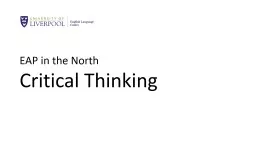

Critical Thinking Jones A 2009 Redisciplining generic attributes the disciplinary context in focus Studies in Higher Education 341 pp 85100 Davies M 2015 A model of critical thinking in Higher Education ID: 573102
Download Presentation The PPT/PDF document "EAP in the North" is the property of its rightful owner. Permission is granted to download and print the materials on this web site for personal, non-commercial use only, and to display it on your personal computer provided you do not modify the materials and that you retain all copyright notices contained in the materials. By downloading content from our website, you accept the terms of this agreement.
Slide1
EAP in the North
Critical ThinkingSlide2
Jones, A. (2009) ‘
Redisciplining generic attributes: the disciplinary context in focus’,
Studies in Higher Education
, 34(1), pp. 85-100
.
Davies, M. (2015) ‘A model of critical thinking in Higher Education’,
Higher Education: Handbook of Theory and Research
, 30, pp. 41-92.Slide3
Davies (2015)Slide4
Delphi Report (
Facione, 1990)We understand critical thinking to be purposeful, self-regulatory judgment which results in interpretation, analysis, evaluation and inference as well as explanation of the evidential, conceptual,
m
ethodological,
criteriological
or contextual considerations upon which that judgment was based. Critical thinking is essential as a tool of inquiry. Critical thinking is a pervasive and self-rectifying human phenomenon. The ideal critical thinker is habitually inquisitive, well-informed, honest in facing personal biases, prudent in making judgments, willing to consider, clear about issues, orderly in complex matters, diligent in seeking relevant information, reasonable in selection of criteria, focused in inquiry and persistent in seeking result which are as precise as the subject and circumstances of inquiry permit.Slide5
‘Generic attributes, as part of the social practice of each discourse community, are often not explicitly taught, but rather picked up through the knowledge or concepts under instruction. So, while it is possible to be more transparent about the ‘rules of the game’, it is difficult to describe them in detail because they are internalised.’ (Jones, 2009, p.
94)Slide6
Critical Thinking: some issues for EAP
1. How, in the EAP classroom, do we illustrate, make explicit and enable engagement in CT?Slide7
‘…generic attributes are highly context-dependent, and are shaped by the disciplinary epistemology in which they are conceptualised and taught.’ (Jones, 2009, p. 85
)
‘…skills such as critical thinking, analysis, problem solving and communication are conceptualised and taught in quite different ways in each of the disciplines.’ (Jones, 2009, p. 85)Slide8
ECONOMICS – use of economic tools; application of theory to practical or policy
issuesHISTORY – awareness of political and ideological dimensions; awareness of gaps and
silences
LAW – examination of legal argumentSlide9
Critical Thinking: some issues for EAP
How, in the EAP classroom, do we illustrate, make explicit and enable engagement in CT
?
How does CT manifest itself in different disciplines?Slide10
‘Heavy rain
causes
flooding.’Slide11
‘Problem solving is closely connected with critical thinking, and an examination of this across disciplines makes the importance of disciplinary knowledge apparent.’ (Jones, 2009, p. 90)
an in-depth understanding of theoretical physics
economic models and the use of economic
theory
an understanding of the principles and conventions of lawSlide12
Critical Thinking: some issues for EAP
How, in the EAP classroom, do we illustrate, make explicit and enable engagement in CT
?
How does CT manifest itself in different disciplines
?
How can the complexity of real world issues be accommodated in the EAP classroom?